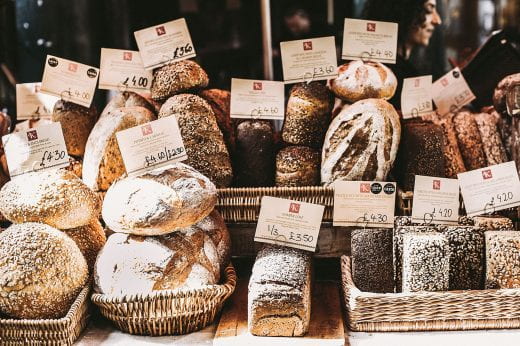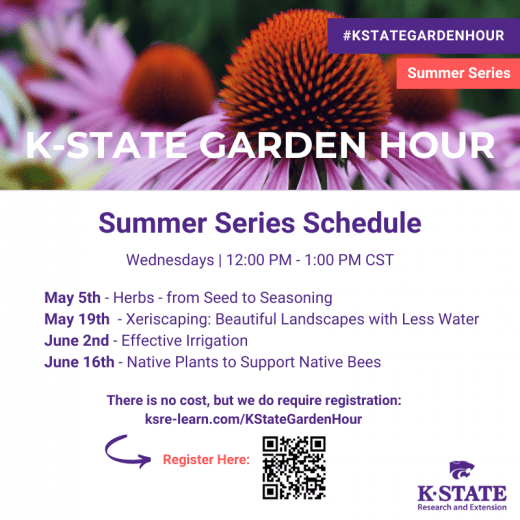This week in Better Kansas I touch on food safety guidance for food stands and bake sales, wheat gluten, Garden Hour webinars, crop scout training and drought as it relates to ranch management. This is a small glimpse of what K-State Research and Extension across the state has to offer. Share on social media and subscribe! – Mary Lou Peter mlpeter@ksu.edu
Better Living, Better Communities
WE’RE GETTING BACK TO NORMAL … SORT OF. At least we’re now able to hold (and attend) some events, and where there are events, there is food, right? The Food and Drug Administration, U.S. Department of Agriculture and Centers for Disease Control and Prevention all recently reaffirmed there is no evidence of COVID-19 transmission via food or food packaging. But for those of us who organize or work food stands and bake sales, K-State Research and Extension has developed recommendations for COVID safety to help mitigate the virus’s transmission from one person to another. If your church, school or community is planning an event, take a look at Safety guidance for food stands and bake sales in 2021. For other food topics, see the food safety web page. And please, stay safe out there.
WHEN STROLLING GROCERY STORE AISLES it doesn’t take long to find a food product labeled “gluten free.” But what is gluten, really? And why should we care? Is it really something to avoid? After all, it gives breads and other baked products their elastic, chewy properties. That makes me think of yummy bagels! Take a look at Gluten and Your Gut’s Good Health for more information about wheat gluten itself, plus facts about celiac disease and other conditions.
Better Farming, Ranching and Gardening
I’M WONDERING HOW MANY OF YOU MOSTLY IGNORED YOUR INDOOR CHORES THE LAST COUPLE OF WEEKENDS, and instead took advantage of gorgeous weather to plant flowers and vegetables? I certainly did! For you like-minded spirits, the popular K-State Garden Hour webinars will continue through the summer and into fall. New topics are featured the first and third Wednesday each month from 12-1 p.m. Take a little break, have a bite to eat and learn about such topics as:
May 19 – Xeriscaping – Beautiful Landscapes with Less Water
June 2 – Effective Irrigation
June 16 – Native Plants to Support Native Bees
Aug. 4 – Organic Gardening
Aug. 18 – Gardening with Beneficial Insects
Sept. 1 – Basics of Growing Berries in Kansas
One-step registration allows your participation in any of the 2021 K-State Garden Hour series and provides access to previously recorded webinars, plus resources you may have missed. Check it out.
FARMERS KNOW THE VALUE OF KEEPING A CLOSE, WELL-TRAINED EYE ON THEIR FIELDS, watching for signs of pests, diseases and other problems that can eat into their crops and profits. To help keep those eyes well trained, a team of crop protection specialists at 11 Midwest universities including K-State, have now come together to produce the 2021 Virtual Crop Scout School free to the public. Read about it in a recent edition of the Agronomy eUpdate, which also touches on cotton stand establishment, stripe rust update in wheat, soybean seeding rates, effect of row spacing on soy yield, and facts about lightning (and staying safe).
I’M A NATIVE KANSAN BUT NEVER KNEW THAT OUR STATE IS LIKELY TO HAVE A DROUGHT THREE OUT OF 10 YEARS. Now that I think of it, that sounds right. When 2021 began, more than 81% of Kansas was experiencing some level of drought. Conditions have improved, however, with the April 29, 2021 U.S. Drought Monitor showing only western Kansas, or about 36% of the state in abnormally dry to severe drought conditions. Read about drought monitoring and ranch management in the May Beef Tips newsletter. Other topics this month cover cleaning winter feeding sites to reduce stable flies and nutrient runoff, the spring breeding season, and mineral supplements. In terms of drought, keep an eye on the western U.S. and the Corn Belt.
https://droughtmonitor.unl.edu/
https://enewsletters.k-state.edu/beeftips/category/may-2021/
_
For more resources and activities, contact the K-State Research and Extension office in your area. Check out our other blogs and subscribe to our weekly emails here: https://www.ksre.k-state.edu/news/blogs/











